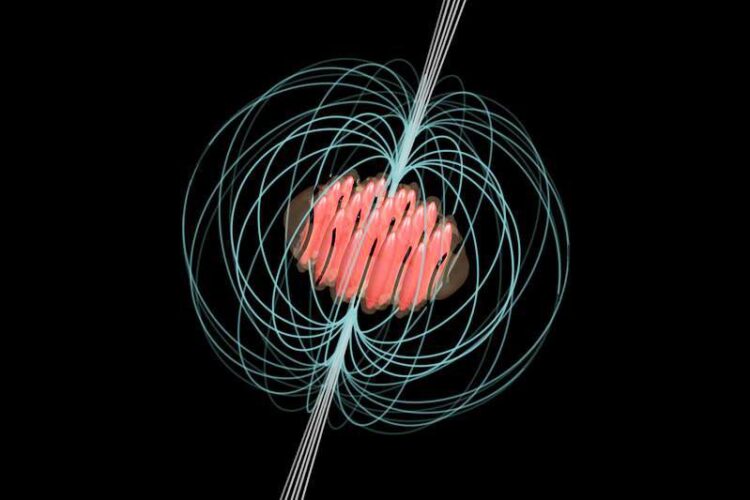Unlocking Neutron Star Rotation Anomalies

Ultracold quantum gases made of dipolar atoms form an ideal platform for simulating mechanisms inside neutron stars.
(c) Elena Poli / Universität Innsbruck
Insights from Quantum Simulation.
A collaboration between quantum physicists and astrophysicists, led by Francesca Ferlaino and Massimo Mannarelli, has achieved a significant breakthrough in understanding neutron star glitches. They were able to numerically simulate this enigmatic cosmic phenomenon with ultracold dipolar atoms. This research establishes a strong link between quantum mechanics and astrophysics and paves the way for quantum simulation of stellar objects from Earth.
Neutron stars have fascinated and puzzled scientists since the first detected signature in 1967. Known for their periodic flashes of light and rapid rotation, neutron stars are among the densest objects in the universe, with a mass comparable to that of the Sun but compressed into a sphere only about 20 kilometers in diameter. These stellar objects exhibit a peculiar behavior known as a “glitch”, where the star suddenly speeds up its spin. This phenomenon suggests that neutron stars might be partly superfluid. In a superfluid, rotation is characterized by numerous tiny vortices, each carrying a fraction of angular momentum. A glitch occurs when these vortices escape from the star’s inner crust to its solid outer crust, thereby increasing the star’s rotational speed.
The key ingredient for this study lies in the concept of a “supersolid” – a state that exhibits both crystalline and superfluid properties – which is predicted to be a necessary ingredient of neutron star glitches. Quantized vortices nest within the supersolid until they collectively escape and are consequently absorbed by the outer crust of the star, accelerating its rotation. Recently, the supersolid phase has been realized in experiments with ultracold dipolar atoms, providing a unique opportunity to simulate the conditions within a neutron star.
The recent study by researchers at the University of Innsbruck and the Austrian Academy of Sciences as well as the Laboratori Nazionali del Gran Sasso and the Gran Sasso Science Institute in Italy demonstrates that glitches can occur in ultracold supersolids, serving as versatile analogues for the inside of neutron stars. This groundbreaking approach allows for a detailed exploration of the glitch mechanism, including its dependence on the quality of the supersolid. “Our research establishes a strong link between quantum mechanics and astrophysics and provides a new perspective on the inner nature of neutron stars”, says first author Elena Poli. Glitches provide valuable insights into the internal structure and dynamics of neutron stars. By studying these events, scientists can learn more about the properties of matter under extreme conditions.
“This research shows a new approach to gain insights into the behavior of neutron stars and opens new avenues for the quantum simulation of stellar objects from low-energy Earth laboratories”, emphasizes Francesca Ferlaino.
The study has been published in Physical Review Letters and was financially supported by the Austrian Science Fund FWF and the European Research Council ERC, among others.
Wissenschaftliche Ansprechpartner:
Francesca Ferlaino
Department of Experimental Physics
University of Innsbruck &
Institute for Quantum Optics and Quantum Information
Austrian Academy of Sciences
+43 512 507-52440
francesca.ferlaino@uibk.ac.at
http://www.erbium.at/
Originalpublikation:
Glitches in rotating supersolids. Elena Poli, Thomas Bland, Samuel J. M. White, Manfred J. Mark, Francesca Ferlaino, Silvia Trabucco and Massimo Mannarelli. Phys. Rev. Lett. 131, 223401 DOI: https://doi.org/10.1103/PhysRevLett.131.223401 [arXiv: https://arxiv.org/abs/2306.09698]
Media Contact
All latest news from the category: Physics and Astronomy
This area deals with the fundamental laws and building blocks of nature and how they interact, the properties and the behavior of matter, and research into space and time and their structures.
innovations-report provides in-depth reports and articles on subjects such as astrophysics, laser technologies, nuclear, quantum, particle and solid-state physics, nanotechnologies, planetary research and findings (Mars, Venus) and developments related to the Hubble Telescope.
Newest articles

Sea slugs inspire highly stretchable biomedical sensor
USC Viterbi School of Engineering researcher Hangbo Zhao presents findings on highly stretchable and customizable microneedles for application in fields including neuroscience, tissue engineering, and wearable bioelectronics. The revolution in…

Twisting and binding matter waves with photons in a cavity
Precisely measuring the energy states of individual atoms has been a historical challenge for physicists due to atomic recoil. When an atom interacts with a photon, the atom “recoils” in…

Nanotubes, nanoparticles, and antibodies detect tiny amounts of fentanyl
New sensor is six orders of magnitude more sensitive than the next best thing. A research team at Pitt led by Alexander Star, a chemistry professor in the Kenneth P. Dietrich…





















